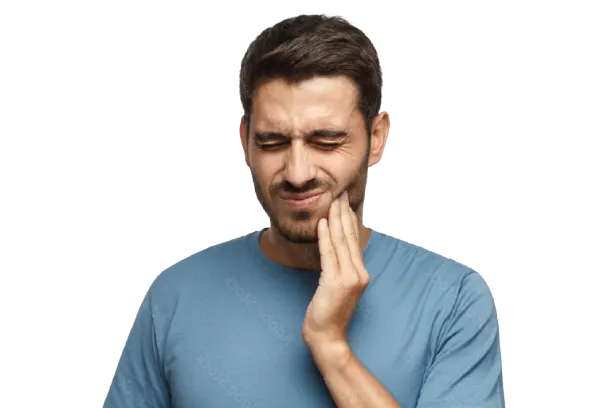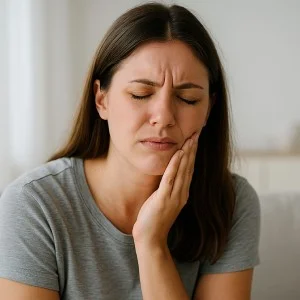TMD vs TMJ: Understanding The Differences
You've probably heard the terms TMJ and TMD mentioned at your dentist's office, but do you know what they mean? These acronyms are often used interchangeably, which can lead to confusion when you're trying to understand what's happening with your jaw pain.
Let's clear things up and talk about the difference between TMJ and TMD, along with their signs, symptoms, and treatment options.
What Is TMJ?
TMJ stands for temporomandibular joint the hinge-like joint connecting your lower jaw to your skull. You have two of these joints, one on each side of your head, located just in front of your ears.
These joints are unique due to their hinging and sliding mobility, which allows your jaw to open, shift left and right, and move forward and backward, and this full range of motion is necessary for eating and speaking.
Signs and Symptoms of TMJ
Your TMJ allows you to perform many daily functions that you might take for granted. With the help of numerous muscles in your face and head, your TMJ makes it possible for you to chew, suck, swallow, speak, change facial expressions, and even breathe properly.
When your TMJ is healthy, you'll enjoy a full range of motion in your jaw without discomfort and you should be able to open and close your mouth, speak, and eat without pain or limitations.
Treatment Options
Since TMJ refers to the joint itself and not a condition, there aren't treatment options specifically for TMJ. Instead, treatments for TMJ vs TMD focus on addressing any disorders affecting these joints, which we'll talk about next.
What Is TMD in Dentistry?
TMD, or temporomandibular joint disorder, refers to a group of conditions affecting your TMJ. While there are more than thirty types of TMDs, they can be classified into three main categories disorders of the muscles around the TMJ (used for chewing), disorders of the joint itself, and headaches associated with TMD.
TMD can affect one or both sides of your face, with symptoms that may be temporary or last for years. In fact, there are as many as ten million Americans who suffer from TMJ disorders.
Signs and Symptoms of TMD
You might have TMD if you experience any of these symptoms:
- Pain or tenderness in your jaw, ears, face, or neck and shoulders
- Locked jaw
- Popping or clicking sounds when opening your jaw
- Discomfort when chewing
- Difficulty opening your mouth wide
- Swelling on the side of your face
- Pain or tenderness in your jaw, ears, face, or neck and shoulders
- Locked jaw
- Popping or clicking sounds when opening your jaw
- Discomfort when chewing
- Difficulty opening your mouth wide
- Swelling on the side of your face
Other TMD symptoms can include stiffness in your jaw muscles, changes in how your upper and lower teeth fit together, headaches, earaches, or ringing in your ears.
Treatment Options
When seeing a dentist for TMD, they'll often use nonsurgical approaches first, as most TMJ disorders are temporary and will fade in time, with only some being chronic.
Treatment options may include:
- Self-care practices like eating soft foods, jaw stretching exercises, and relaxation techniques
- Medications such as pain relievers, muscle relaxers, or antidepressants
- Mouth guards to prevent teeth grinding or clenching
- Physical therapy
- Botox injections
- CBD treatments
- Surgery (usually as a last resort)
- Self-care practices like eating soft foods, jaw stretching exercises, and relaxation techniques
- Medications such as pain relievers, muscle relaxers, or antidepressants
- Mouth guards to prevent teeth grinding or clenching
- Physical therapy
- Botox injections
- CBD treatments
- Surgery (usually as a last resort)
TMD vs TMJ: Frequently Asked Questions
What is the difference between TMJ and TMD disorder?
TMJ and TMD are not the same thing. TMJ is the joint itself, while TMD is the disorder affecting that joint. Think of it like this your knee is a joint, but knee pain is a condition affecting that joint.
How Long Does Temporomandibular Joint Disorder Last?
TMJ dysfunction affects everyone differently. It can result in temporary discomfort or chronic jaw pain that lasts for months or even years, but your specific experience will depend on the cause of your TMD, your treatment plan, and how your body responds to treatment.
How do you treat TMD temporomandibular disorder?
Treatment varies based on the specific cause of your TMD, your age, your general health, how long you've been living with symptoms, and your preferences. We will recommend a personalized treatment plan after we evaluate you.
What is the first line treatment for TMD?
The first approach often includes self-care methods such as eating soft foods, correcting your posture, using hot or cold compresses, and avoiding habits like jaw clenching or teeth grinding
What can be mistaken for TMD?
Because TMJs rely on many things working just right, it's no surprise that disorders involving them are so common. Conditions like sinus infections, ear infections, arthritis, or even dental problems can present similar symptoms.
What is often misdiagnosed as TMJ?
Headaches, including migraines, are sometimes misdiagnosed as TMD and vice versa, which is why it's important to see a specialist who understands the complexities of jaw and facial pain.
Final Thoughts
Understanding the difference between TMJ and TMD is important for effective communication with your healthcare providers. If you're experiencing jaw pain or related symptoms, don't hesitate to seek professional help.
With proper diagnosis and treatment, you can find relief from TMD symptoms and improve your quality of life.
Table of Contents
- TMJ Flare Up Symptoms
- TMJ Flare Up Causes
- How to Avoid Triggering a TMJ Flare Up
- Look to The Experts
Start treatment for Sleep Apnea and TMJ disorders today.
Request an Appointment











